|
|
|
| |
Ibike
Korea People-to-People Program
|
| |
|
| |
|
| |
|
 Photo essay: Taebaek to
Ulchin Photo essay: Taebaek to
Ulchin
|
| |
|
(53mi, 85km) After the last of the mountains, head down valleys to the
coast road – but there still will be hills.
Points of Interest: coal mines, narrow canyons, garlic and pepper farms, Nuclear
power plant |
| |
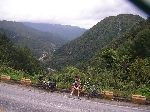
|
After climbing out of the valley that
Taebaek is in it is largely downhill to the sea. The panoramic view would
have been better on a cloudless day, but we could still enjoy the view of the
road ahead. |
| |
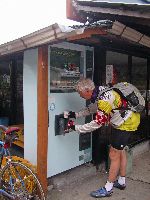
|
 Coffee machines are almost
ubiquitous. They can be on almost every block in a city, inside business,
at any kind of roadside attraction and stand alone in a gravel parking lot.
This one is outside of a very small store at the junction of two lightly
traveled road, but it is just enough to keep a cyclist going. Coffee machines are almost
ubiquitous. They can be on almost every block in a city, inside business,
at any kind of roadside attraction and stand alone in a gravel parking lot.
This one is outside of a very small store at the junction of two lightly
traveled road, but it is just enough to keep a cyclist going. |
| |
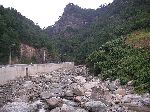
|
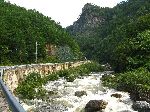 The road and river share the same
gorge. In 2003, torrential rains and floods had ripped out dozens of
miles of roads in this canyon. By 2004, the road had been total rebuilt -- better than
they were before. Typhoons still hit the area regularly and damage the
road. It accumulates more patches almost annually. The road and river share the same
gorge. In 2003, torrential rains and floods had ripped out dozens of
miles of roads in this canyon. By 2004, the road had been total rebuilt -- better than
they were before. Typhoons still hit the area regularly and damage the
road. It accumulates more patches almost annually. |
| |
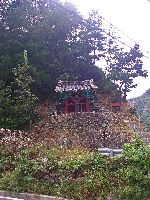
|
The accompanying sign says: "Min
Sun-ho and his wife, Mme. Park from a Juksan family, lived at Ojeo-ri during the
reign of King Gojong. When Min's parents were sick in bed, the couple
scoured the mountains and rivers to collect herbs to use as medicine.
Their great care worked and the parents were able to recover their health.
Mme. Park was celebrated for her hospitality in welcoming guests. When her
husband, was once close to death with illness, Mme. Park cut her finger and
saved him by feeding him her blood. In 1885, the 22nd year of King
Gonjong's reign, the King ordered the magistrate of Samcheok to honor Min Sun-ho
as a devoted son and Mme. Park as a faithful woman. The hyoyeolmun was
built to honor their filial piety." |
| |
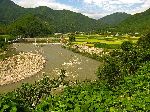 |
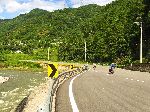 Besides the general scenery the
picture shows the nature of the river bank work, bridging and channelization
that common on South Korea rivers. It is not unusual to see large bridges
within a kilometer of each other, some serving a single farm. Massive
reworking of rivers is not usually good for the ecology of the river, but there
is no indication that this is an issue yet in South Korea. Besides the general scenery the
picture shows the nature of the river bank work, bridging and channelization
that common on South Korea rivers. It is not unusual to see large bridges
within a kilometer of each other, some serving a single farm. Massive
reworking of rivers is not usually good for the ecology of the river, but there
is no indication that this is an issue yet in South Korea. |
| |
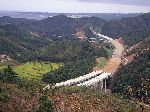
|
 The
relocation and rebuilding of Hwy 7 (2004) should make cycling may get even
better along the central east coast. Throughout the country there is a huge amount of
construction on express ways, which tend to take traffic off of rural roads. These roads tunnel in onside of a hill and
pop out the other and then float above the valleys in between the mountains.
As they are completed they pull long distance traffic off the old highways
leaving more spaces for cyclists. The
relocation and rebuilding of Hwy 7 (2004) should make cycling may get even
better along the central east coast. Throughout the country there is a huge amount of
construction on express ways, which tend to take traffic off of rural roads. These roads tunnel in onside of a hill and
pop out the other and then float above the valleys in between the mountains.
As they are completed they pull long distance traffic off the old highways
leaving more spaces for cyclists. |
| |
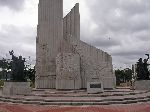
|
Monument to technological advance at
Ulchin Nuclear Power Plant. On the transportation panel, also feature an
antique car and jet airplane, there is a high wheeler bike.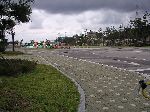 Ulchin Nuclear Power Plant, one of
twenty nuclear power plants in South Korea that account for 40% of the country's
electric output. The gateway sculpture is an
oversize model of atoms. The reactor vessel and cooling towers are on the
right side of the picture. |
| |
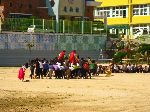 |
On one pass through Ulchin,
the students at this school were having a game-day. In the game shown, a
contestant on each team would dress like royalty and then walk on the backs of
their team mates for the length of the course. The teammate had to keep
cycling back to the head of the line to keep the forward progress. Other
games were relays and other team activities, often with themes or props drawn
from traditional culture. |
| |
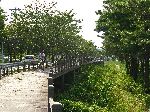 |
Sometimes in conjunction
with highway project and sometimes as stand alone projects, there are are
efforts to improve conditions for cycling along the east coast. To date
(2013) the improve are pretty discontinuous so if you are going any distance you
are frequently popped back out on to busy highways and the bicycle facilities
are generally poorly signed so you need prior knowledge to find many of the more
bicycle-friendly links. |
| |
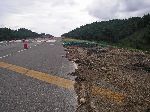
|
Fish nets drying on the highway
(now block to traffic).
Coincidentally this highway is straight enough, long enough (3 km) and marked to
be a landing strip for jet aircraft. It doesn't appear to be actively used
so presumably it has been built in case of an emergency. |
| |
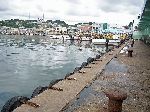
|
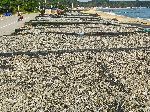 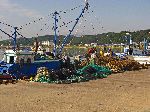 The fishing boat fleet in Chukpyeon
harbor, one of the nicest harbors on the east coast of Korea. The fishing boat fleet in Chukpyeon
harbor, one of the nicest harbors on the east coast of Korea.From the fishing
boats comes the fish catch, many of which are set to dry in long racks along the
side of the road (far right photo). |
| |
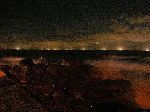
|
If you are up
after sundown or before sunrise you can see a bright white glow on the horizons,
almost turning the night into day. These are the high powered lights of scores
of squid fishing boats that foreshadow the quirkiness of the day. By sunrise,
the boats have turned off their lights and melted away. If you see them coming
back into port they are far less formidable than you might have imagined. |
| |
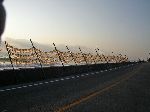
|
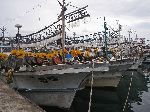 But
even before the sun is full in the sky the squid economy is texturing the view
as the drying lines catch the first rays of the sunrise.
To the left are quid left out over night, basking in the sunrise. But
even before the sun is full in the sky the squid economy is texturing the view
as the drying lines catch the first rays of the sunrise.
To the left are quid left out over night, basking in the sunrise.
To the right are squid boats in Chukpyeon harbor.
Squid boats are characterized by their long row of high powered light bulbs.
The boats fish at night and the lights attract the squid. |
| |
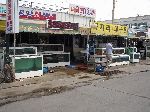
|
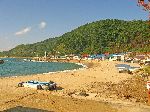 The water front street of Chukpyeon
(and most other coastal towns and villages) is lined with "Hoe" (fresh fish)
restaurants. The restaurants are identifiable by the array of fish tanks
in front. The water front street of Chukpyeon
(and most other coastal towns and villages) is lined with "Hoe" (fresh fish)
restaurants. The restaurants are identifiable by the array of fish tanks
in front. |
| |
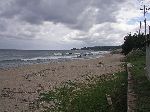 |
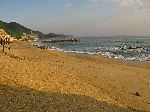 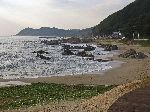 Most of the coast is quite rocky so
sandy beaches are the exception. This is a nice sandy beach south of Chukpyeon, but the weather
isn't always nice enough to make you want to feel like
throwing yourself into the surf. Most of the coast is quite rocky so
sandy beaches are the exception. This is a nice sandy beach south of Chukpyeon, but the weather
isn't always nice enough to make you want to feel like
throwing yourself into the surf. |
| |
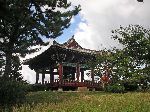
|
Mangyangjeong (pavilion) was
originally built during the Goryeo period (918-1392) at the foot of Hyeonjongsan
(mountain). It was moved to the present location in 1858. It was rebuilt
in 1958 and repaired in 1979. |
| |
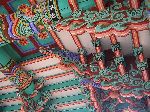
|
Mangyangjeong is considered one
of the eight most scenic spots of the east coast of Gangwon-do and Gyeongsangbuk-do.
Note: The country has it eight most scenic spots, provinces have their eight
most scenic spots, rivers have their eight most scenic spots, etc. |
| |
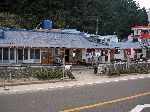
|
This is a fairly typical minbak
(lodging) in a fishing village along the coast. The big building to the
left is the family house and the small building to the right has several rooms
for guests (typically 2-4). The bathroom is separate again. Sleeping
is "ondol" and they have no accessories, but they generally cost the same or
more than a room in a yeogwan (small hotel). |
| |
|
|
| |
Taebeak

 Ganggu Ganggu |
|
    |
 |
|
|
 Please
contact us if you would like to be added to
Ibike's mailing list or have questions, comments, corrections or criticism. (Also, please let us know how you learned about us and
found this site.) Privacy policy. Please
contact us if you would like to be added to
Ibike's mailing list or have questions, comments, corrections or criticism. (Also, please let us know how you learned about us and
found this site.) Privacy policy.
 IBF Homepage
IBF Homepage  Ibike Programs
Ibike Programs
 Ibike Schedule
Ibike Schedule
 Search
Search
"Hosted by
DreamHost - earth friendly web hosting"
Created by David Mozer
Copyright ?1993-2018 Ibike LLC. All rights reserved.
|
 Photo essay: Taebaek to
Ulchin
Photo essay: Taebaek to
Ulchin

 Coffee machines are almost
ubiquitous. They can be on almost every block in a city, inside business,
at any kind of roadside attraction and stand alone in a gravel parking lot.
This one is outside of a very small store at the junction of two lightly
traveled road, but it is just enough to keep a cyclist going.
Coffee machines are almost
ubiquitous. They can be on almost every block in a city, inside business,
at any kind of roadside attraction and stand alone in a gravel parking lot.
This one is outside of a very small store at the junction of two lightly
traveled road, but it is just enough to keep a cyclist going.
 The road and river share the same
gorge. In 2003, torrential rains and floods had ripped out dozens of
miles of roads in this canyon. By 2004, the road had been total rebuilt -- better than
they were before. Typhoons still hit the area regularly and damage the
road. It accumulates more patches almost annually.
The road and river share the same
gorge. In 2003, torrential rains and floods had ripped out dozens of
miles of roads in this canyon. By 2004, the road had been total rebuilt -- better than
they were before. Typhoons still hit the area regularly and damage the
road. It accumulates more patches almost annually.

 Besides the general scenery the
picture shows the nature of the river bank work, bridging and channelization
that common on South Korea rivers. It is not unusual to see large bridges
within a kilometer of each other, some serving a single farm. Massive
reworking of rivers is not usually good for the ecology of the river, but there
is no indication that this is an issue yet in South Korea.
Besides the general scenery the
picture shows the nature of the river bank work, bridging and channelization
that common on South Korea rivers. It is not unusual to see large bridges
within a kilometer of each other, some serving a single farm. Massive
reworking of rivers is not usually good for the ecology of the river, but there
is no indication that this is an issue yet in South Korea.
 The
relocation and rebuilding of Hwy 7 (2004) should make cycling may get even
better along the central east coast. Throughout the country there is a huge amount of
construction on express ways, which tend to take traffic off of rural roads. These roads tunnel in onside of a hill and
pop out the other and then float above the valleys in between the mountains.
As they are completed they pull long distance traffic off the old highways
leaving more spaces for cyclists.
The
relocation and rebuilding of Hwy 7 (2004) should make cycling may get even
better along the central east coast. Throughout the country there is a huge amount of
construction on express ways, which tend to take traffic off of rural roads. These roads tunnel in onside of a hill and
pop out the other and then float above the valleys in between the mountains.
As they are completed they pull long distance traffic off the old highways
leaving more spaces for cyclists.






 The fishing boat fleet in Chukpyeon
harbor, one of the nicest harbors on the east coast of Korea.
The fishing boat fleet in Chukpyeon
harbor, one of the nicest harbors on the east coast of Korea.

 But
even before the sun is full in the sky the squid economy is texturing the view
as the drying lines catch the first rays of the sunrise.
To the left are quid left out over night, basking in the sunrise.
But
even before the sun is full in the sky the squid economy is texturing the view
as the drying lines catch the first rays of the sunrise.
To the left are quid left out over night, basking in the sunrise.
 The water front street of Chukpyeon
(and most other coastal towns and villages) is lined with "Hoe" (fresh fish)
restaurants. The restaurants are identifiable by the array of fish tanks
in front.
The water front street of Chukpyeon
(and most other coastal towns and villages) is lined with "Hoe" (fresh fish)
restaurants. The restaurants are identifiable by the array of fish tanks
in front.

 Most of the coast is quite rocky so
sandy beaches are the exception. This is a nice sandy beach south of Chukpyeon, but the weather
isn't always nice enough to make you want to feel like
throwing yourself into the surf.
Most of the coast is quite rocky so
sandy beaches are the exception. This is a nice sandy beach south of Chukpyeon, but the weather
isn't always nice enough to make you want to feel like
throwing yourself into the surf.


 Please
contact us if you would like to be added to
Ibike's mailing list or have questions, comments, corrections or criticism. (Also, please let us know how you learned about us and
found this site.) Privacy policy.
Please
contact us if you would like to be added to
Ibike's mailing list or have questions, comments, corrections or criticism. (Also, please let us know how you learned about us and
found this site.) Privacy policy.![]() IBF Homepage
IBF Homepage ![]() Ibike Programs
Ibike Programs
![]() Ibike Schedule
Ibike Schedule
![]() Search
Search


